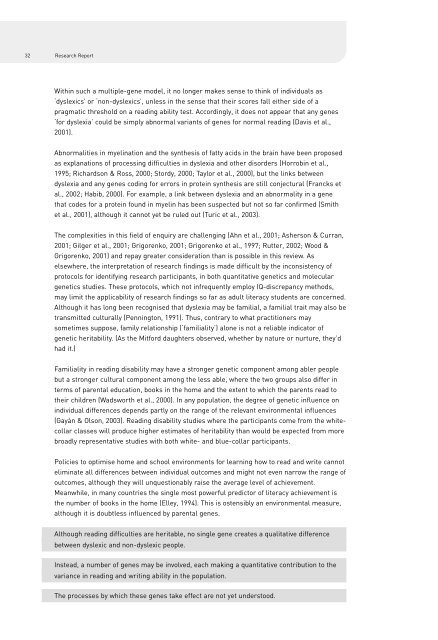01 NRDC Dyslexia 1-88 update - Texthelp
01 NRDC Dyslexia 1-88 update - Texthelp
01 NRDC Dyslexia 1-88 update - Texthelp
You also want an ePaper? Increase the reach of your titles
YUMPU automatically turns print PDFs into web optimized ePapers that Google loves.
32<br />
Research Report<br />
Within such a multiple-gene model, it no longer makes sense to think of individuals as<br />
‘dyslexics’ or ‘non-dyslexics’, unless in the sense that their scores fall either side of a<br />
pragmatic threshold on a reading ability test. Accordingly, it does not appear that any genes<br />
‘for dyslexia’ could be simply abnormal variants of genes for normal reading (Davis et al.,<br />
20<strong>01</strong>).<br />
Abnormalities in myelination and the synthesis of fatty acids in the brain have been proposed<br />
as explanations of processing difficulties in dyslexia and other disorders (Horrobin et al.,<br />
1995; Richardson & Ross, 2000; Stordy, 2000; Taylor et al., 2000), but the links between<br />
dyslexia and any genes coding for errors in protein synthesis are still conjectural (Francks et<br />
al., 2002; Habib, 2000). For example, a link between dyslexia and an abnormality in a gene<br />
that codes for a protein found in myelin has been suspected but not so far confirmed (Smith<br />
et al., 20<strong>01</strong>), although it cannot yet be ruled out (Turic et al., 2003).<br />
The complexities in this field of enquiry are challenging (Ahn et al., 20<strong>01</strong>; Asherson & Curran,<br />
20<strong>01</strong>; Gilger et al., 20<strong>01</strong>; Grigorenko, 20<strong>01</strong>; Grigorenko et al., 1997; Rutter, 2002; Wood &<br />
Grigorenko, 20<strong>01</strong>) and repay greater consideration than is possible in this review. As<br />
elsewhere, the interpretation of research findings is made difficult by the inconsistency of<br />
protocols for identifying research participants, in both quantitative genetics and molecular<br />
genetics studies. These protocols, which not infrequently employ IQ-discrepancy methods,<br />
may limit the applicability of research findings so far as adult literacy students are concerned.<br />
Although it has long been recognised that dyslexia may be familial, a familial trait may also be<br />
transmitted culturally (Pennington, 1991). Thus, contrary to what practitioners may<br />
sometimes suppose, family relationship (‘familiality’) alone is not a reliable indicator of<br />
genetic heritability. (As the Mitford daughters observed, whether by nature or nurture, they’d<br />
had it.)<br />
Familiality in reading disability may have a stronger genetic component among abler people<br />
but a stronger cultural component among the less able, where the two groups also differ in<br />
terms of parental education, books in the home and the extent to which the parents read to<br />
their children (Wadsworth et al., 2000). In any population, the degree of genetic influence on<br />
individual differences depends partly on the range of the relevant environmental influences<br />
(Gayán & Olson, 2003). Reading disability studies where the participants come from the whitecollar<br />
classes will produce higher estimates of heritability than would be expected from more<br />
broadly representative studies with both white- and blue-collar participants.<br />
Policies to optimise home and school environments for learning how to read and write cannot<br />
eliminate all differences between individual outcomes and might not even narrow the range of<br />
outcomes, although they will unquestionably raise the average level of achievement.<br />
Meanwhile, in many countries the single most powerful predictor of literacy achievement is<br />
the number of books in the home (Elley, 1994). This is ostensibly an environmental measure,<br />
although it is doubtless influenced by parental genes.<br />
Although reading difficulties are heritable, no single gene creates a qualitative difference<br />
between dyslexic and non-dyslexic people.<br />
Instead, a number of genes may be involved, each making a quantitative contribution to the<br />
variance in reading and writing ability in the population.<br />
The processes by which these genes take effect are not yet understood.
















